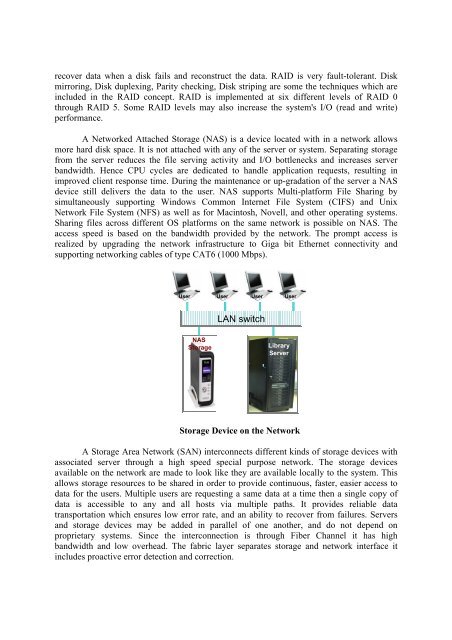READIT - 2009 - Indira Gandhi Centre for Atomic Research
READIT - 2009 - Indira Gandhi Centre for Atomic Research
READIT - 2009 - Indira Gandhi Centre for Atomic Research
You also want an ePaper? Increase the reach of your titles
YUMPU automatically turns print PDFs into web optimized ePapers that Google loves.
ecover data when a disk fails and reconstruct the data. RAID is very fault-tolerant. Disk<br />
mirroring, Disk duplexing, Parity checking, Disk striping are some the techniques which are<br />
included in the RAID concept. RAID is implemented at six different levels of RAID 0<br />
through RAID 5. Some RAID levels may also increase the system's I/O (read and write)<br />
per<strong>for</strong>mance.<br />
A Networked Attached Storage (NAS) is a device located with in a network allows<br />
more hard disk space. It is not attached with any of the server or system. Separating storage<br />
from the server reduces the file serving activity and I/O bottlenecks and increases server<br />
bandwidth. Hence CPU cycles are dedicated to handle application requests, resulting in<br />
improved client response time. During the maintenance or up-gradation of the server a NAS<br />
device still delivers the data to the user. NAS supports Multi-plat<strong>for</strong>m File Sharing by<br />
simultaneously supporting Windows Common Internet File System (CIFS) and Unix<br />
Network File System (NFS) as well as <strong>for</strong> Macintosh, Novell, and other operating systems.<br />
Sharing files across different OS plat<strong>for</strong>ms on the same network is possible on NAS. The<br />
access speed is based on the bandwidth provided by the network. The prompt access is<br />
realized by upgrading the network infrastructure to Giga bit Ethernet connectivity and<br />
supporting networking cables of type CAT6 (1000 Mbps).<br />
User<br />
User<br />
User<br />
User<br />
LAN switch<br />
NAS<br />
Storage<br />
Library<br />
Server<br />
Storage Device on the Network<br />
A Storage Area Network (SAN) interconnects different kinds of storage devices with<br />
associated server through a high speed special purpose network. The storage devices<br />
available on the network are made to look like they are available locally to the system. This<br />
allows storage resources to be shared in order to provide continuous, faster, easier access to<br />
data <strong>for</strong> the users. Multiple users are requesting a same data at a time then a single copy of<br />
data is accessible to any and all hosts via multiple paths. It provides reliable data<br />
transportation which ensures low error rate, and an ability to recover from failures. Servers<br />
and storage devices may be added in parallel of one another, and do not depend on<br />
proprietary systems. Since the interconnection is through Fiber Channel it has high<br />
bandwidth and low overhead. The fabric layer separates storage and network interface it<br />
includes proactive error detection and correction.

















